Analysis of Healthcare for Australian Indigenous Communities
VerifiedAdded on 2023/01/20
|9
|2288
|21
Report
AI Summary
This report reviews a case study focusing on the healthcare experiences of the Australian Aboriginal community, particularly in relation to the Torres Strait Islander population. The paper examines the status of Indigenous Australians in terms of healthcare and accommodation, analyzing the impact of government acts and schemes designed to protect them from discrimination and promote their well-being. The case study involves a young Aboriginal man facing challenges in a nursing home, highlighting issues of discrimination and the importance of culturally safe care. The report discusses factors affecting Indigenous Australians' integration into mainstream society, the advantages and disadvantages they face, and advocates for their fundamental rights. It also explores the role of Aboriginal Community Controlled Health Services (ACCHS) and government initiatives like "closing the gap," as well as the contributions of Aboriginal and Torres Strait Islander health practitioners in addressing healthcare disparities and promoting cultural safety within the healthcare system. The report concludes by emphasizing the importance of self-determination and the need for healthcare workers to develop culturally sensitive approaches to improve the overall health and well-being of Indigenous communities.
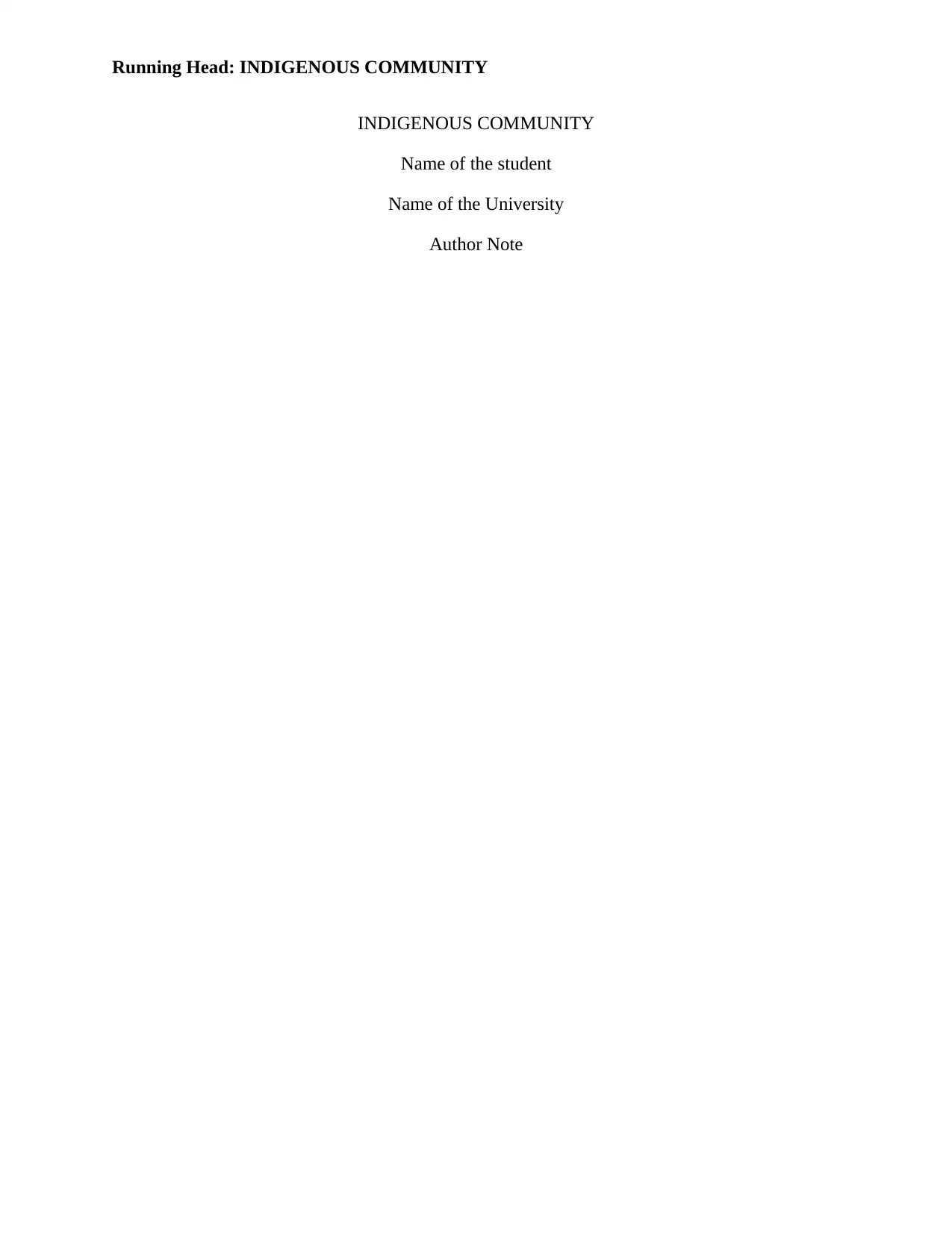
Running Head: INDIGENOUS COMMUNITY
INDIGENOUS COMMUNITY
Name of the student
Name of the University
Author Note
INDIGENOUS COMMUNITY
Name of the student
Name of the University
Author Note
Paraphrase This Document
Need a fresh take? Get an instant paraphrase of this document with our AI Paraphraser
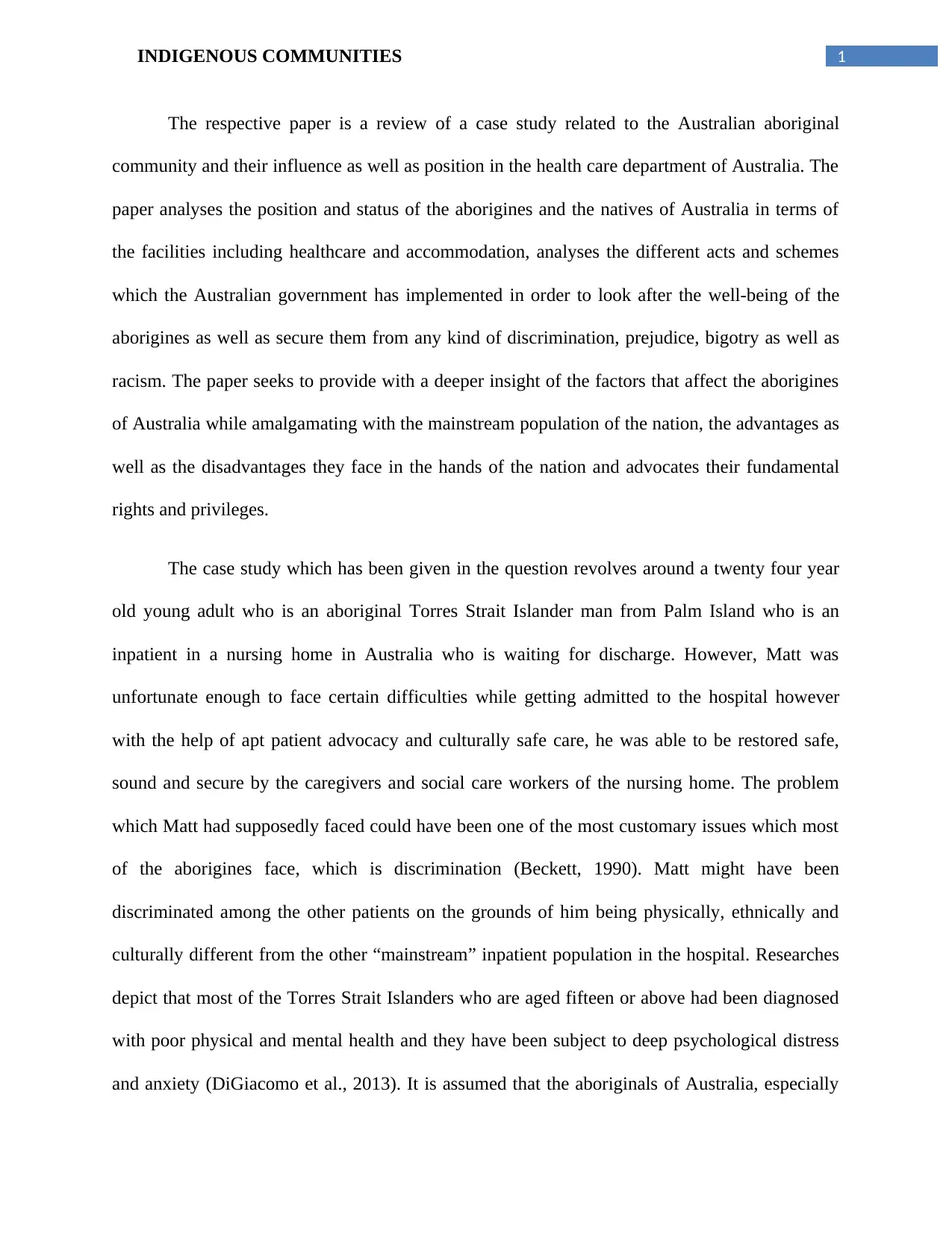
1INDIGENOUS COMMUNITIES
The respective paper is a review of a case study related to the Australian aboriginal
community and their influence as well as position in the health care department of Australia. The
paper analyses the position and status of the aborigines and the natives of Australia in terms of
the facilities including healthcare and accommodation, analyses the different acts and schemes
which the Australian government has implemented in order to look after the well-being of the
aborigines as well as secure them from any kind of discrimination, prejudice, bigotry as well as
racism. The paper seeks to provide with a deeper insight of the factors that affect the aborigines
of Australia while amalgamating with the mainstream population of the nation, the advantages as
well as the disadvantages they face in the hands of the nation and advocates their fundamental
rights and privileges.
The case study which has been given in the question revolves around a twenty four year
old young adult who is an aboriginal Torres Strait Islander man from Palm Island who is an
inpatient in a nursing home in Australia who is waiting for discharge. However, Matt was
unfortunate enough to face certain difficulties while getting admitted to the hospital however
with the help of apt patient advocacy and culturally safe care, he was able to be restored safe,
sound and secure by the caregivers and social care workers of the nursing home. The problem
which Matt had supposedly faced could have been one of the most customary issues which most
of the aborigines face, which is discrimination (Beckett, 1990). Matt might have been
discriminated among the other patients on the grounds of him being physically, ethnically and
culturally different from the other “mainstream” inpatient population in the hospital. Researches
depict that most of the Torres Strait Islanders who are aged fifteen or above had been diagnosed
with poor physical and mental health and they have been subject to deep psychological distress
and anxiety (DiGiacomo et al., 2013). It is assumed that the aboriginals of Australia, especially
The respective paper is a review of a case study related to the Australian aboriginal
community and their influence as well as position in the health care department of Australia. The
paper analyses the position and status of the aborigines and the natives of Australia in terms of
the facilities including healthcare and accommodation, analyses the different acts and schemes
which the Australian government has implemented in order to look after the well-being of the
aborigines as well as secure them from any kind of discrimination, prejudice, bigotry as well as
racism. The paper seeks to provide with a deeper insight of the factors that affect the aborigines
of Australia while amalgamating with the mainstream population of the nation, the advantages as
well as the disadvantages they face in the hands of the nation and advocates their fundamental
rights and privileges.
The case study which has been given in the question revolves around a twenty four year
old young adult who is an aboriginal Torres Strait Islander man from Palm Island who is an
inpatient in a nursing home in Australia who is waiting for discharge. However, Matt was
unfortunate enough to face certain difficulties while getting admitted to the hospital however
with the help of apt patient advocacy and culturally safe care, he was able to be restored safe,
sound and secure by the caregivers and social care workers of the nursing home. The problem
which Matt had supposedly faced could have been one of the most customary issues which most
of the aborigines face, which is discrimination (Beckett, 1990). Matt might have been
discriminated among the other patients on the grounds of him being physically, ethnically and
culturally different from the other “mainstream” inpatient population in the hospital. Researches
depict that most of the Torres Strait Islanders who are aged fifteen or above had been diagnosed
with poor physical and mental health and they have been subject to deep psychological distress
and anxiety (DiGiacomo et al., 2013). It is assumed that the aboriginals of Australia, especially
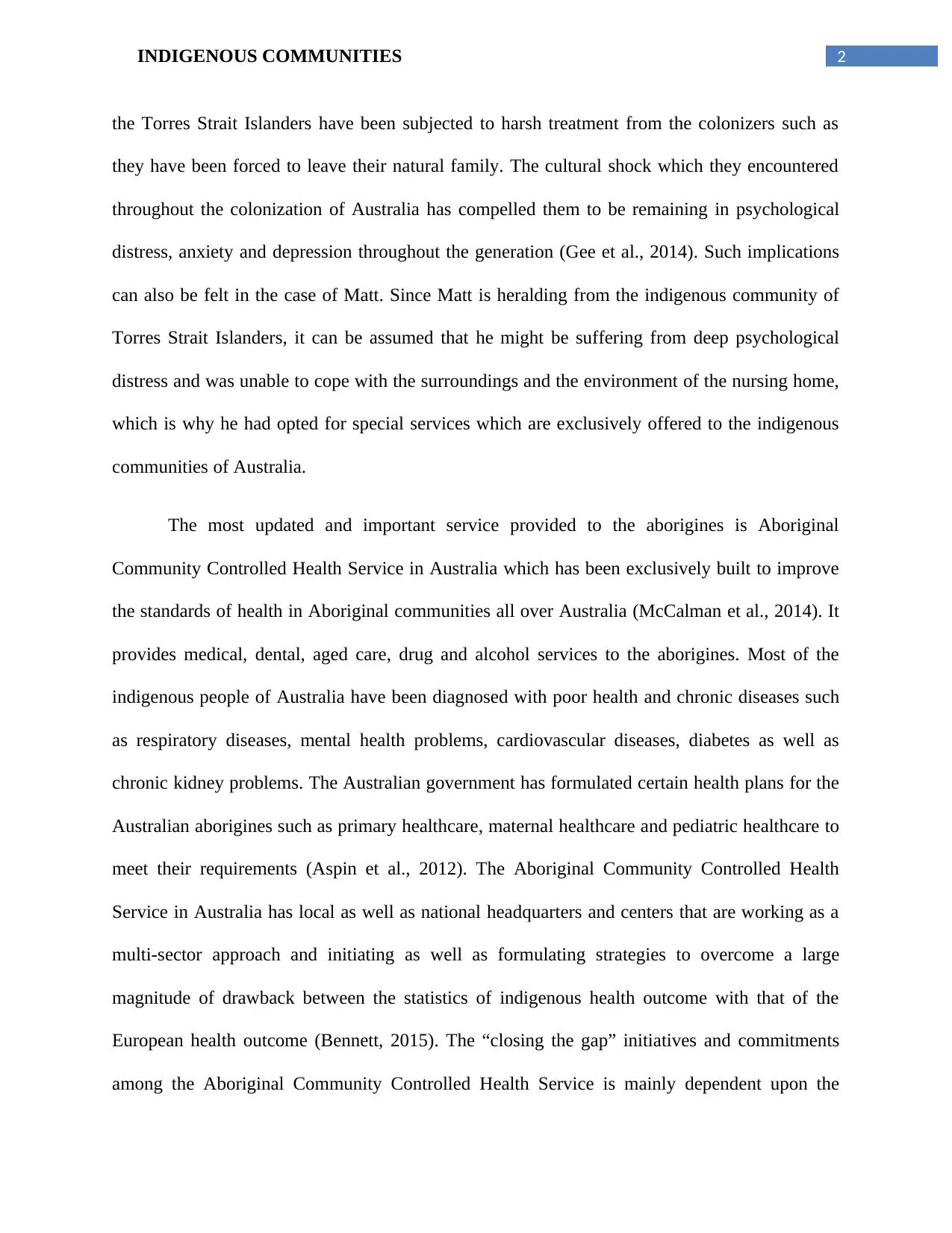
2INDIGENOUS COMMUNITIES
the Torres Strait Islanders have been subjected to harsh treatment from the colonizers such as
they have been forced to leave their natural family. The cultural shock which they encountered
throughout the colonization of Australia has compelled them to be remaining in psychological
distress, anxiety and depression throughout the generation (Gee et al., 2014). Such implications
can also be felt in the case of Matt. Since Matt is heralding from the indigenous community of
Torres Strait Islanders, it can be assumed that he might be suffering from deep psychological
distress and was unable to cope with the surroundings and the environment of the nursing home,
which is why he had opted for special services which are exclusively offered to the indigenous
communities of Australia.
The most updated and important service provided to the aborigines is Aboriginal
Community Controlled Health Service in Australia which has been exclusively built to improve
the standards of health in Aboriginal communities all over Australia (McCalman et al., 2014). It
provides medical, dental, aged care, drug and alcohol services to the aborigines. Most of the
indigenous people of Australia have been diagnosed with poor health and chronic diseases such
as respiratory diseases, mental health problems, cardiovascular diseases, diabetes as well as
chronic kidney problems. The Australian government has formulated certain health plans for the
Australian aborigines such as primary healthcare, maternal healthcare and pediatric healthcare to
meet their requirements (Aspin et al., 2012). The Aboriginal Community Controlled Health
Service in Australia has local as well as national headquarters and centers that are working as a
multi-sector approach and initiating as well as formulating strategies to overcome a large
magnitude of drawback between the statistics of indigenous health outcome with that of the
European health outcome (Bennett, 2015). The “closing the gap” initiatives and commitments
among the Aboriginal Community Controlled Health Service is mainly dependent upon the
the Torres Strait Islanders have been subjected to harsh treatment from the colonizers such as
they have been forced to leave their natural family. The cultural shock which they encountered
throughout the colonization of Australia has compelled them to be remaining in psychological
distress, anxiety and depression throughout the generation (Gee et al., 2014). Such implications
can also be felt in the case of Matt. Since Matt is heralding from the indigenous community of
Torres Strait Islanders, it can be assumed that he might be suffering from deep psychological
distress and was unable to cope with the surroundings and the environment of the nursing home,
which is why he had opted for special services which are exclusively offered to the indigenous
communities of Australia.
The most updated and important service provided to the aborigines is Aboriginal
Community Controlled Health Service in Australia which has been exclusively built to improve
the standards of health in Aboriginal communities all over Australia (McCalman et al., 2014). It
provides medical, dental, aged care, drug and alcohol services to the aborigines. Most of the
indigenous people of Australia have been diagnosed with poor health and chronic diseases such
as respiratory diseases, mental health problems, cardiovascular diseases, diabetes as well as
chronic kidney problems. The Australian government has formulated certain health plans for the
Australian aborigines such as primary healthcare, maternal healthcare and pediatric healthcare to
meet their requirements (Aspin et al., 2012). The Aboriginal Community Controlled Health
Service in Australia has local as well as national headquarters and centers that are working as a
multi-sector approach and initiating as well as formulating strategies to overcome a large
magnitude of drawback between the statistics of indigenous health outcome with that of the
European health outcome (Bennett, 2015). The “closing the gap” initiatives and commitments
among the Aboriginal Community Controlled Health Service is mainly dependent upon the
⊘ This is a preview!⊘
Do you want full access?
Subscribe today to unlock all pages.

Trusted by 1+ million students worldwide
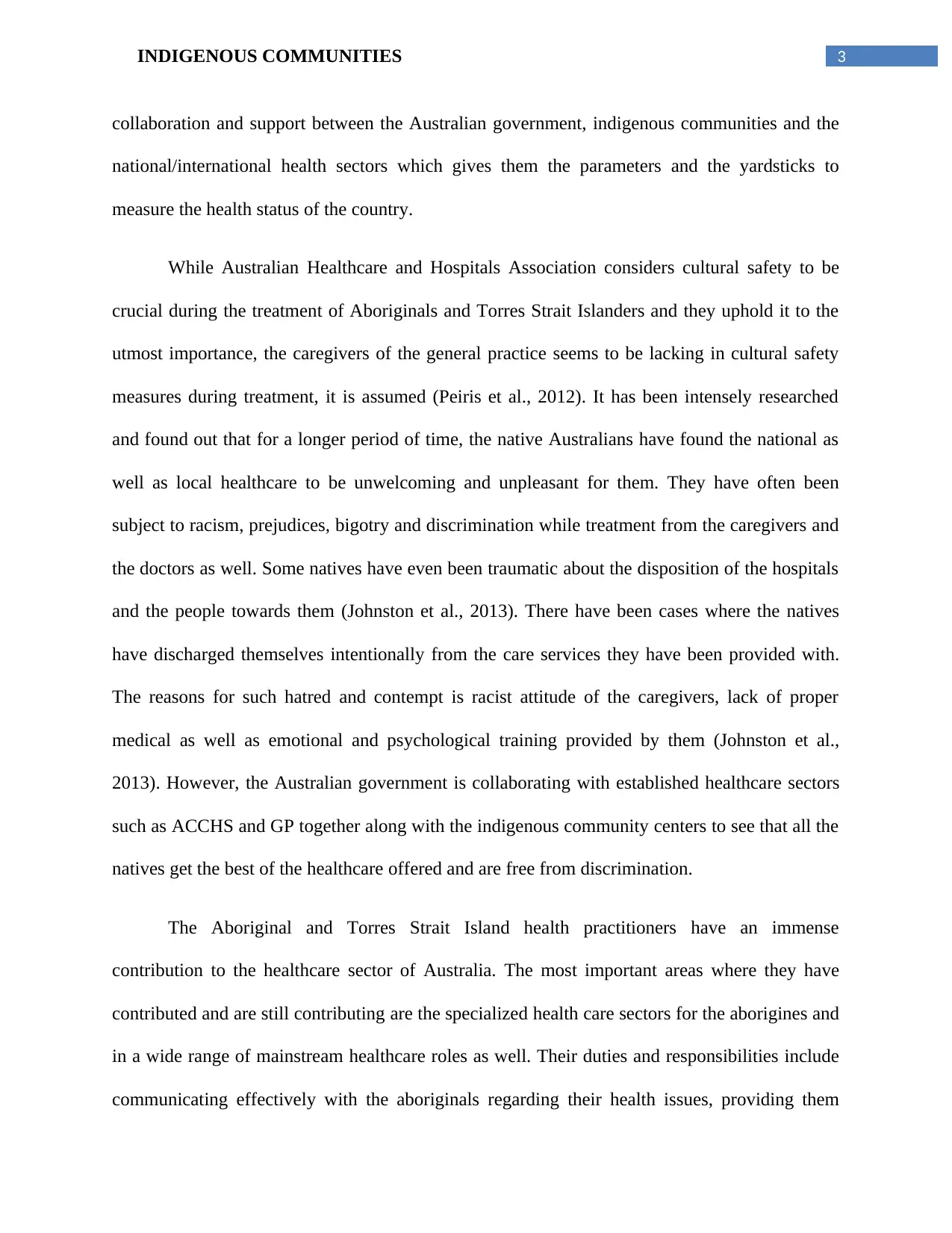
3INDIGENOUS COMMUNITIES
collaboration and support between the Australian government, indigenous communities and the
national/international health sectors which gives them the parameters and the yardsticks to
measure the health status of the country.
While Australian Healthcare and Hospitals Association considers cultural safety to be
crucial during the treatment of Aboriginals and Torres Strait Islanders and they uphold it to the
utmost importance, the caregivers of the general practice seems to be lacking in cultural safety
measures during treatment, it is assumed (Peiris et al., 2012). It has been intensely researched
and found out that for a longer period of time, the native Australians have found the national as
well as local healthcare to be unwelcoming and unpleasant for them. They have often been
subject to racism, prejudices, bigotry and discrimination while treatment from the caregivers and
the doctors as well. Some natives have even been traumatic about the disposition of the hospitals
and the people towards them (Johnston et al., 2013). There have been cases where the natives
have discharged themselves intentionally from the care services they have been provided with.
The reasons for such hatred and contempt is racist attitude of the caregivers, lack of proper
medical as well as emotional and psychological training provided by them (Johnston et al.,
2013). However, the Australian government is collaborating with established healthcare sectors
such as ACCHS and GP together along with the indigenous community centers to see that all the
natives get the best of the healthcare offered and are free from discrimination.
The Aboriginal and Torres Strait Island health practitioners have an immense
contribution to the healthcare sector of Australia. The most important areas where they have
contributed and are still contributing are the specialized health care sectors for the aborigines and
in a wide range of mainstream healthcare roles as well. Their duties and responsibilities include
communicating effectively with the aboriginals regarding their health issues, providing them
collaboration and support between the Australian government, indigenous communities and the
national/international health sectors which gives them the parameters and the yardsticks to
measure the health status of the country.
While Australian Healthcare and Hospitals Association considers cultural safety to be
crucial during the treatment of Aboriginals and Torres Strait Islanders and they uphold it to the
utmost importance, the caregivers of the general practice seems to be lacking in cultural safety
measures during treatment, it is assumed (Peiris et al., 2012). It has been intensely researched
and found out that for a longer period of time, the native Australians have found the national as
well as local healthcare to be unwelcoming and unpleasant for them. They have often been
subject to racism, prejudices, bigotry and discrimination while treatment from the caregivers and
the doctors as well. Some natives have even been traumatic about the disposition of the hospitals
and the people towards them (Johnston et al., 2013). There have been cases where the natives
have discharged themselves intentionally from the care services they have been provided with.
The reasons for such hatred and contempt is racist attitude of the caregivers, lack of proper
medical as well as emotional and psychological training provided by them (Johnston et al.,
2013). However, the Australian government is collaborating with established healthcare sectors
such as ACCHS and GP together along with the indigenous community centers to see that all the
natives get the best of the healthcare offered and are free from discrimination.
The Aboriginal and Torres Strait Island health practitioners have an immense
contribution to the healthcare sector of Australia. The most important areas where they have
contributed and are still contributing are the specialized health care sectors for the aborigines and
in a wide range of mainstream healthcare roles as well. Their duties and responsibilities include
communicating effectively with the aboriginals regarding their health issues, providing them
Paraphrase This Document
Need a fresh take? Get an instant paraphrase of this document with our AI Paraphraser
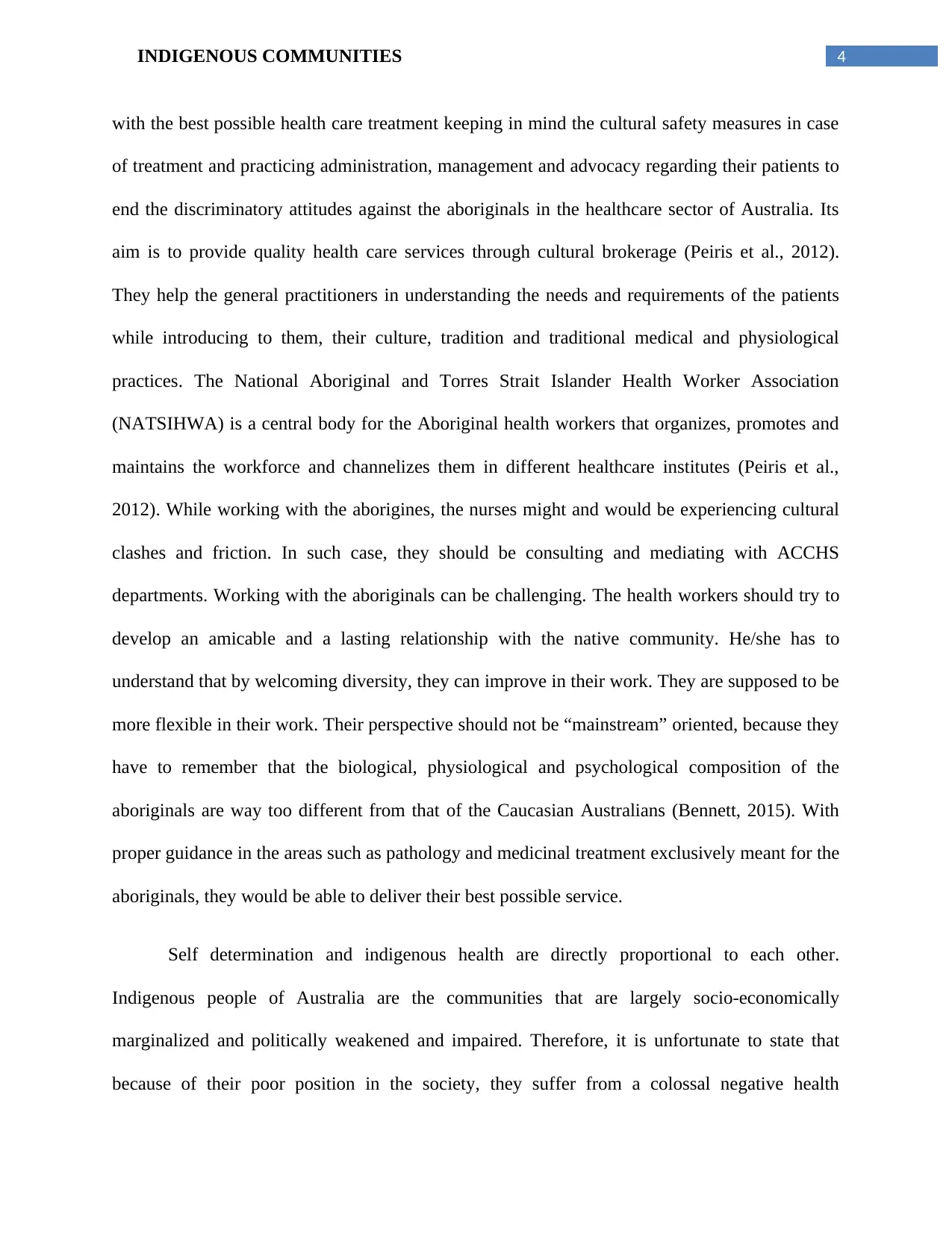
4INDIGENOUS COMMUNITIES
with the best possible health care treatment keeping in mind the cultural safety measures in case
of treatment and practicing administration, management and advocacy regarding their patients to
end the discriminatory attitudes against the aboriginals in the healthcare sector of Australia. Its
aim is to provide quality health care services through cultural brokerage (Peiris et al., 2012).
They help the general practitioners in understanding the needs and requirements of the patients
while introducing to them, their culture, tradition and traditional medical and physiological
practices. The National Aboriginal and Torres Strait Islander Health Worker Association
(NATSIHWA) is a central body for the Aboriginal health workers that organizes, promotes and
maintains the workforce and channelizes them in different healthcare institutes (Peiris et al.,
2012). While working with the aborigines, the nurses might and would be experiencing cultural
clashes and friction. In such case, they should be consulting and mediating with ACCHS
departments. Working with the aboriginals can be challenging. The health workers should try to
develop an amicable and a lasting relationship with the native community. He/she has to
understand that by welcoming diversity, they can improve in their work. They are supposed to be
more flexible in their work. Their perspective should not be “mainstream” oriented, because they
have to remember that the biological, physiological and psychological composition of the
aboriginals are way too different from that of the Caucasian Australians (Bennett, 2015). With
proper guidance in the areas such as pathology and medicinal treatment exclusively meant for the
aboriginals, they would be able to deliver their best possible service.
Self determination and indigenous health are directly proportional to each other.
Indigenous people of Australia are the communities that are largely socio-economically
marginalized and politically weakened and impaired. Therefore, it is unfortunate to state that
because of their poor position in the society, they suffer from a colossal negative health
with the best possible health care treatment keeping in mind the cultural safety measures in case
of treatment and practicing administration, management and advocacy regarding their patients to
end the discriminatory attitudes against the aboriginals in the healthcare sector of Australia. Its
aim is to provide quality health care services through cultural brokerage (Peiris et al., 2012).
They help the general practitioners in understanding the needs and requirements of the patients
while introducing to them, their culture, tradition and traditional medical and physiological
practices. The National Aboriginal and Torres Strait Islander Health Worker Association
(NATSIHWA) is a central body for the Aboriginal health workers that organizes, promotes and
maintains the workforce and channelizes them in different healthcare institutes (Peiris et al.,
2012). While working with the aborigines, the nurses might and would be experiencing cultural
clashes and friction. In such case, they should be consulting and mediating with ACCHS
departments. Working with the aboriginals can be challenging. The health workers should try to
develop an amicable and a lasting relationship with the native community. He/she has to
understand that by welcoming diversity, they can improve in their work. They are supposed to be
more flexible in their work. Their perspective should not be “mainstream” oriented, because they
have to remember that the biological, physiological and psychological composition of the
aboriginals are way too different from that of the Caucasian Australians (Bennett, 2015). With
proper guidance in the areas such as pathology and medicinal treatment exclusively meant for the
aboriginals, they would be able to deliver their best possible service.
Self determination and indigenous health are directly proportional to each other.
Indigenous people of Australia are the communities that are largely socio-economically
marginalized and politically weakened and impaired. Therefore, it is unfortunate to state that
because of their poor position in the society, they suffer from a colossal negative health
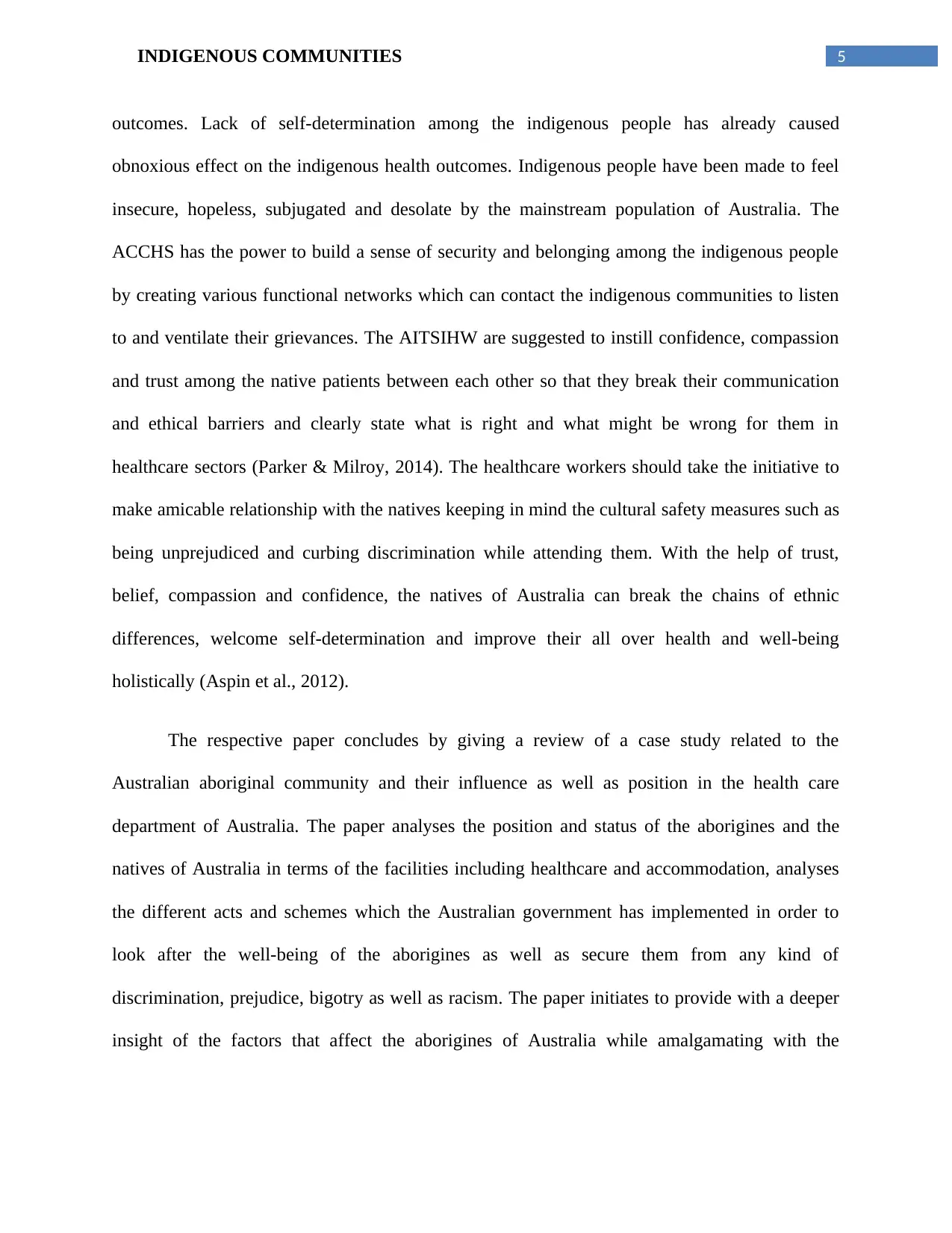
5INDIGENOUS COMMUNITIES
outcomes. Lack of self-determination among the indigenous people has already caused
obnoxious effect on the indigenous health outcomes. Indigenous people have been made to feel
insecure, hopeless, subjugated and desolate by the mainstream population of Australia. The
ACCHS has the power to build a sense of security and belonging among the indigenous people
by creating various functional networks which can contact the indigenous communities to listen
to and ventilate their grievances. The AITSIHW are suggested to instill confidence, compassion
and trust among the native patients between each other so that they break their communication
and ethical barriers and clearly state what is right and what might be wrong for them in
healthcare sectors (Parker & Milroy, 2014). The healthcare workers should take the initiative to
make amicable relationship with the natives keeping in mind the cultural safety measures such as
being unprejudiced and curbing discrimination while attending them. With the help of trust,
belief, compassion and confidence, the natives of Australia can break the chains of ethnic
differences, welcome self-determination and improve their all over health and well-being
holistically (Aspin et al., 2012).
The respective paper concludes by giving a review of a case study related to the
Australian aboriginal community and their influence as well as position in the health care
department of Australia. The paper analyses the position and status of the aborigines and the
natives of Australia in terms of the facilities including healthcare and accommodation, analyses
the different acts and schemes which the Australian government has implemented in order to
look after the well-being of the aborigines as well as secure them from any kind of
discrimination, prejudice, bigotry as well as racism. The paper initiates to provide with a deeper
insight of the factors that affect the aborigines of Australia while amalgamating with the
outcomes. Lack of self-determination among the indigenous people has already caused
obnoxious effect on the indigenous health outcomes. Indigenous people have been made to feel
insecure, hopeless, subjugated and desolate by the mainstream population of Australia. The
ACCHS has the power to build a sense of security and belonging among the indigenous people
by creating various functional networks which can contact the indigenous communities to listen
to and ventilate their grievances. The AITSIHW are suggested to instill confidence, compassion
and trust among the native patients between each other so that they break their communication
and ethical barriers and clearly state what is right and what might be wrong for them in
healthcare sectors (Parker & Milroy, 2014). The healthcare workers should take the initiative to
make amicable relationship with the natives keeping in mind the cultural safety measures such as
being unprejudiced and curbing discrimination while attending them. With the help of trust,
belief, compassion and confidence, the natives of Australia can break the chains of ethnic
differences, welcome self-determination and improve their all over health and well-being
holistically (Aspin et al., 2012).
The respective paper concludes by giving a review of a case study related to the
Australian aboriginal community and their influence as well as position in the health care
department of Australia. The paper analyses the position and status of the aborigines and the
natives of Australia in terms of the facilities including healthcare and accommodation, analyses
the different acts and schemes which the Australian government has implemented in order to
look after the well-being of the aborigines as well as secure them from any kind of
discrimination, prejudice, bigotry as well as racism. The paper initiates to provide with a deeper
insight of the factors that affect the aborigines of Australia while amalgamating with the
⊘ This is a preview!⊘
Do you want full access?
Subscribe today to unlock all pages.

Trusted by 1+ million students worldwide
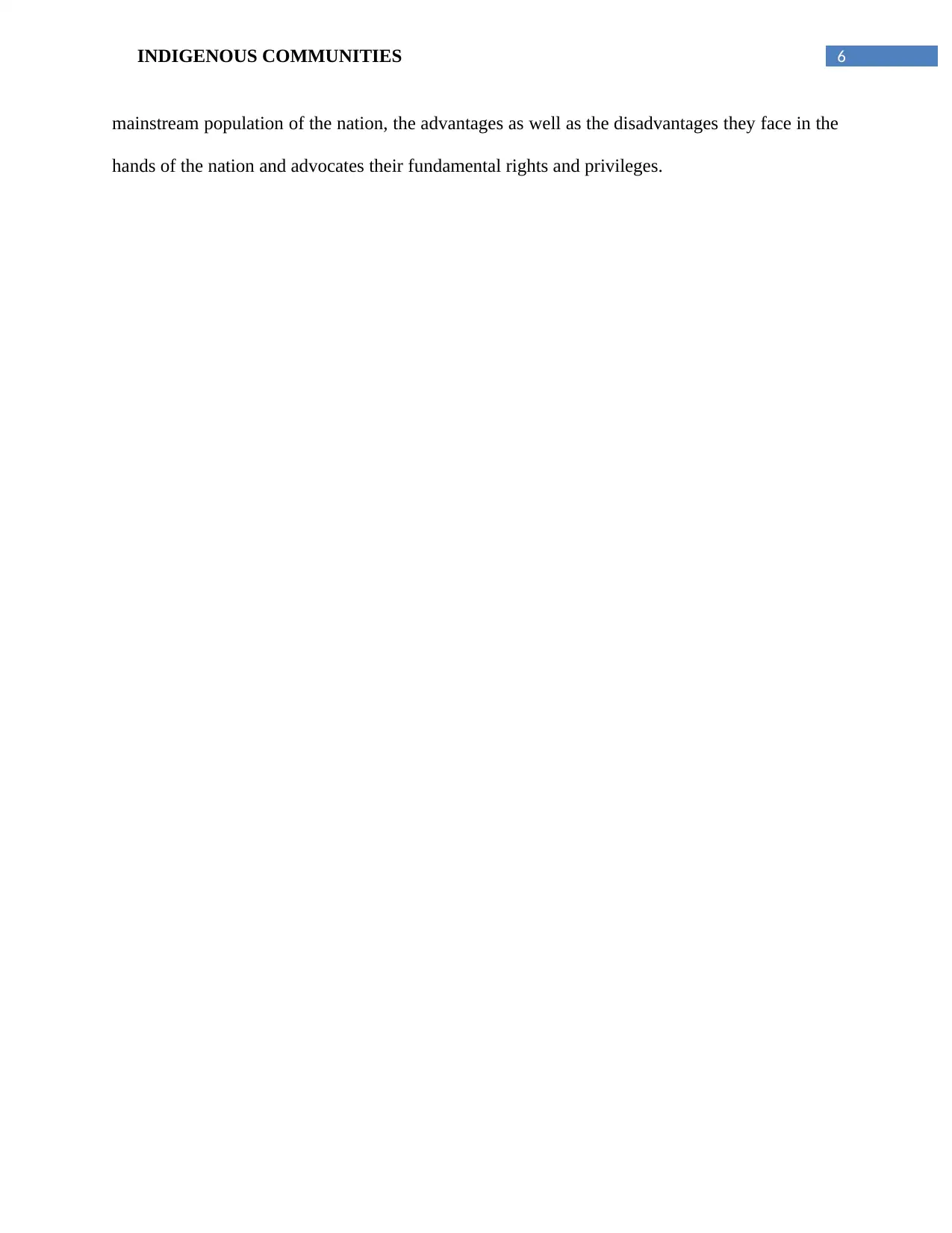
6INDIGENOUS COMMUNITIES
mainstream population of the nation, the advantages as well as the disadvantages they face in the
hands of the nation and advocates their fundamental rights and privileges.
mainstream population of the nation, the advantages as well as the disadvantages they face in the
hands of the nation and advocates their fundamental rights and privileges.
Paraphrase This Document
Need a fresh take? Get an instant paraphrase of this document with our AI Paraphraser
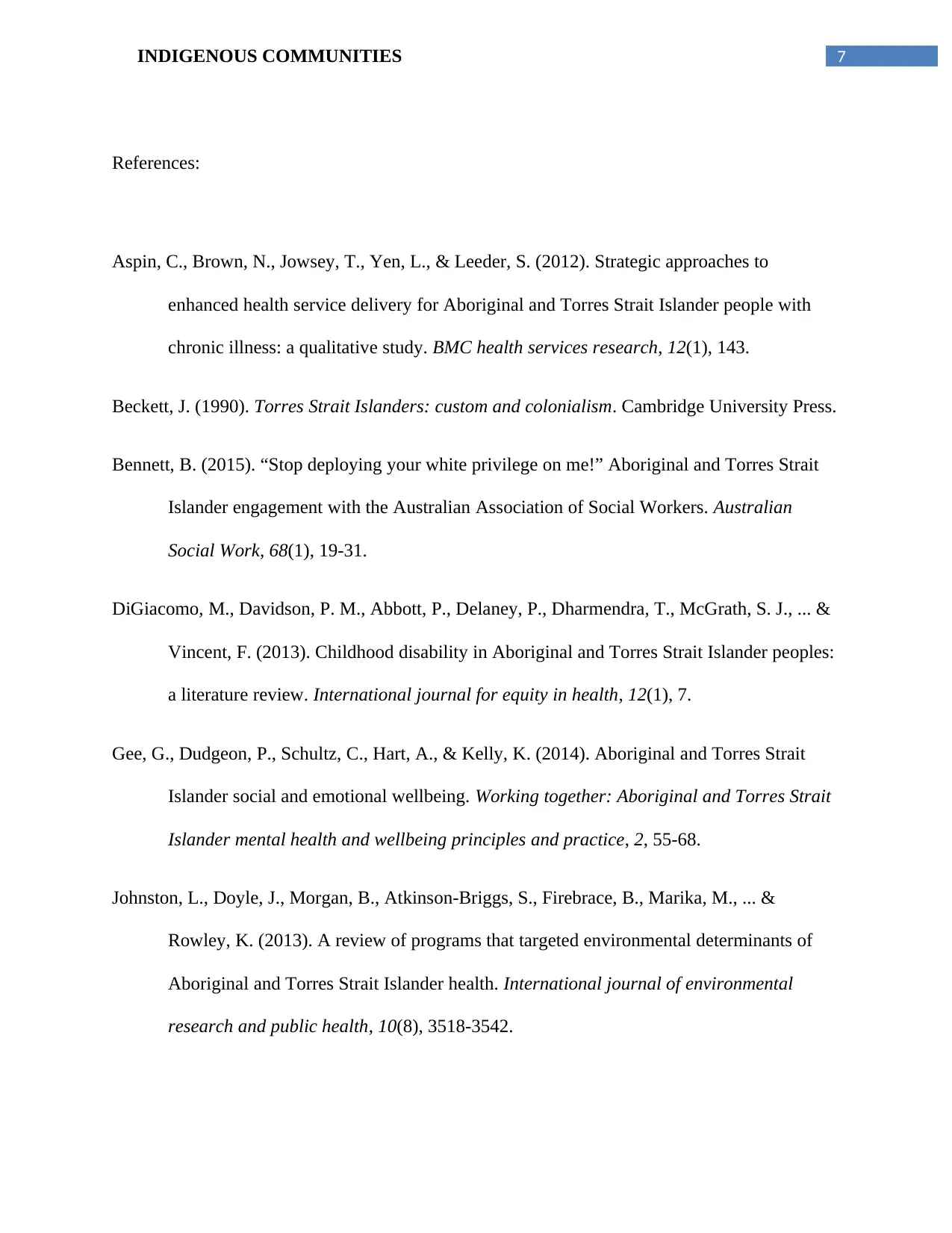
7INDIGENOUS COMMUNITIES
References:
Aspin, C., Brown, N., Jowsey, T., Yen, L., & Leeder, S. (2012). Strategic approaches to
enhanced health service delivery for Aboriginal and Torres Strait Islander people with
chronic illness: a qualitative study. BMC health services research, 12(1), 143.
Beckett, J. (1990). Torres Strait Islanders: custom and colonialism. Cambridge University Press.
Bennett, B. (2015). “Stop deploying your white privilege on me!” Aboriginal and Torres Strait
Islander engagement with the Australian Association of Social Workers. Australian
Social Work, 68(1), 19-31.
DiGiacomo, M., Davidson, P. M., Abbott, P., Delaney, P., Dharmendra, T., McGrath, S. J., ... &
Vincent, F. (2013). Childhood disability in Aboriginal and Torres Strait Islander peoples:
a literature review. International journal for equity in health, 12(1), 7.
Gee, G., Dudgeon, P., Schultz, C., Hart, A., & Kelly, K. (2014). Aboriginal and Torres Strait
Islander social and emotional wellbeing. Working together: Aboriginal and Torres Strait
Islander mental health and wellbeing principles and practice, 2, 55-68.
Johnston, L., Doyle, J., Morgan, B., Atkinson-Briggs, S., Firebrace, B., Marika, M., ... &
Rowley, K. (2013). A review of programs that targeted environmental determinants of
Aboriginal and Torres Strait Islander health. International journal of environmental
research and public health, 10(8), 3518-3542.
References:
Aspin, C., Brown, N., Jowsey, T., Yen, L., & Leeder, S. (2012). Strategic approaches to
enhanced health service delivery for Aboriginal and Torres Strait Islander people with
chronic illness: a qualitative study. BMC health services research, 12(1), 143.
Beckett, J. (1990). Torres Strait Islanders: custom and colonialism. Cambridge University Press.
Bennett, B. (2015). “Stop deploying your white privilege on me!” Aboriginal and Torres Strait
Islander engagement with the Australian Association of Social Workers. Australian
Social Work, 68(1), 19-31.
DiGiacomo, M., Davidson, P. M., Abbott, P., Delaney, P., Dharmendra, T., McGrath, S. J., ... &
Vincent, F. (2013). Childhood disability in Aboriginal and Torres Strait Islander peoples:
a literature review. International journal for equity in health, 12(1), 7.
Gee, G., Dudgeon, P., Schultz, C., Hart, A., & Kelly, K. (2014). Aboriginal and Torres Strait
Islander social and emotional wellbeing. Working together: Aboriginal and Torres Strait
Islander mental health and wellbeing principles and practice, 2, 55-68.
Johnston, L., Doyle, J., Morgan, B., Atkinson-Briggs, S., Firebrace, B., Marika, M., ... &
Rowley, K. (2013). A review of programs that targeted environmental determinants of
Aboriginal and Torres Strait Islander health. International journal of environmental
research and public health, 10(8), 3518-3542.

8INDIGENOUS COMMUNITIES
McCalman, J., Tsey, K., Bainbridge, R., Rowley, K., Percival, N., O’Donoghue, L., ... & Judd, J.
(2014). The characteristics, implementation and effects of Aboriginal and Torres Strait
Islander health promotion tools: a systematic literature search. BMC Public Health, 14(1),
712.
Parker, R., & Milroy, H. (2014). Aboriginal and Torres Strait Islander mental health: an
overview. Working together: Aboriginal and Torres Strait Islander mental health and
wellbeing principles and practice. 2nd ed. Canberra: Department of The Prime Minister
and Cabinet, 25-38.
Peiris, D., Brown, A., Howard, M., Rickards, B. A., Tonkin, A., Ring, I., ... & Cass, A. (2012).
Building better systems of care for Aboriginal and Torres Strait Islander people: findings
from the Kanyini health systems assessment. BMC Health Services Research, 12(1), 369.
McCalman, J., Tsey, K., Bainbridge, R., Rowley, K., Percival, N., O’Donoghue, L., ... & Judd, J.
(2014). The characteristics, implementation and effects of Aboriginal and Torres Strait
Islander health promotion tools: a systematic literature search. BMC Public Health, 14(1),
712.
Parker, R., & Milroy, H. (2014). Aboriginal and Torres Strait Islander mental health: an
overview. Working together: Aboriginal and Torres Strait Islander mental health and
wellbeing principles and practice. 2nd ed. Canberra: Department of The Prime Minister
and Cabinet, 25-38.
Peiris, D., Brown, A., Howard, M., Rickards, B. A., Tonkin, A., Ring, I., ... & Cass, A. (2012).
Building better systems of care for Aboriginal and Torres Strait Islander people: findings
from the Kanyini health systems assessment. BMC Health Services Research, 12(1), 369.
⊘ This is a preview!⊘
Do you want full access?
Subscribe today to unlock all pages.

Trusted by 1+ million students worldwide
1 out of 9
Related Documents
Your All-in-One AI-Powered Toolkit for Academic Success.
+13062052269
info@desklib.com
Available 24*7 on WhatsApp / Email
![[object Object]](/_next/static/media/star-bottom.7253800d.svg)
Unlock your academic potential
Copyright © 2020–2025 A2Z Services. All Rights Reserved. Developed and managed by ZUCOL.





